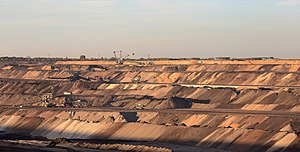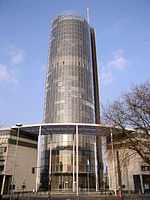Garzweiler surface mine
This article may be expanded with text translated from the corresponding article in German. (June 2017) Click [show] for important translation instructions.
|
 Panoramic view of Tagebau Garzweiler | |
| Location | |
|---|---|
| Country | Germany |
| Coordinates | 51°03′15″N 6°30′35″E / 51.05417°N 6.50972°ECoordinates: 51°03′15″N 6°30′35″E / 51.05417°N 6.50972°E |
| Production | |
| Products | Lignite |
| Owner | |
| Company | RWE |
The Tagebau Garzweiler is a surface mine (German: Tagebau) in the German state of North Rhine-Westphalia. It is operated by RWE and used for mining lignite.[1] The mine currently has a size of 48 km² and got its name from the village of Garzweiler which previously existed at this location. The community was moved to a section of Jüchen with the same name.[2]
The open-pit mine

The mine is located west of Grevenbroich and exploitation is progressing towards Erkelenz. Mining was originally limited to the 66.0 km² area Garzweiler I located east of motorway A 44. Mining in the 48.0 km² Garzweiler II sector started in 2006 and it will take until around 2045 to fully exploit both sectors. The lignite is used for power generation at nearby power plants such as Neurath[3] and Niederaußem.
It is not yet known what effect the plan to phase out all coal-fired power plants in Germany by 2038 will have on the Garzweiler lignite mine system.[4]
Traffic
Motorways A 44 and A 61 crossing the planned mine area are also affected. The A 44 was closed in 2005, dismantled in 2006 and traffic rerouted to the widened A 61 and A 46 motorways. In 2017, as the mine expanded to the west, the A 61 was closed with traffic diverted onto a stretch of newly built A 44 to the east of its original route.
Displacement of people
In the early 80's it is estimated that more than 30.000 people had to be moved for the Garzweiler mine.[5] These people had to leave their houses and move to somewhere else. Garzweiler II required that 12 more towns had to be removed, where around 12.000 more people had to be moved. This has caused many controversies where people protested to save their homes. There are many different opinions on whether this displacement of the local inhabitants is a good case. According to Wolfgang Rupieper, head of Pro Lausitzer Braunkohle, which is a pro-coal lobbying association based in another brown coal mining area in Germany, the resettlement is not a bad thing. He states: "Coal is the motor of the region, and when it collapses there won't be anything left, I know it's not pretty, but people who don't have a future here because there are no jobs will lose their homes too. They'll have to go elsewhere."[6]
See also
- Church of St. Lambertus, Immerath
- Berverath
- Keyenberg
- Kuckum
- Oberwestrich
- Unterwestrich
- North–South industrial spur
- Schloss Paffendorf
- Straße der Energie ("Street of energy")
- Ende Gelände 2015
- Ende Gelände 2019
- Inden open pit mine
- Hambach open pit mine
- Rhenish lignite mining area
- List of lignite mines in Germany
- List of active mines in Germany
- Commission on Growth, Structural Change and Employment
References
- ^ Barry, John (2002). International Encyclopedia of International Politics. Taylor & Francis. p. 216. ISBN 9780415202855. Retrieved 2013-05-26.
- ^ Rolf Sevenich: Garzweiler II. Kersting, Aachen 1996, ISBN 3-928047-12-4.
- ^ Hambachgruppe: Verheizte Heimat – Der Braunkohletagebau und seine Folgen. Aachen 1985, ISBN 3-924007-14-4 (PDF)
- ^ Kirschbaum, Erik (January 26, 2019). "Germany to close all 84 of its coal-fired power plants, will rely primarily on renewable energy". Los Angeles Times. Archived from the original on 2019-01-30. Retrieved January 27, 2019.
Germany, one of the world’s biggest consumers of coal, will shut down all 84 of its coal-fired power plants over the next 19 years to meet its international commitments in the fight against climate change, a government commission said Saturday.
- ^ Aben, T.T., Kroonen, K.J., Piket, J.J. & Puts, P.J.P. (2021) Make a little space for the human race. Retrieved 8 December 2021.
- ^ Andrew Curry for National Geografic. (2014). Germany Plans to Raze Towns for Brown Coal and Cheap Energy


